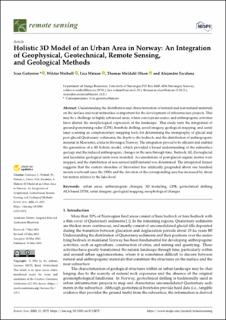| dc.contributor.author | Gutierrez Mozo, Ivan David | |
| dc.contributor.author | Weibull, Wiktor Waldemar | |
| dc.contributor.author | Watson, Lisa | |
| dc.contributor.author | Olsen, Thomas Meldahl | |
| dc.contributor.author | Escalona Varela, Alejandro | |
| dc.coverage.spatial | Norway, Stavanger | en_US |
| dc.date.accessioned | 2023-11-10T13:08:53Z | |
| dc.date.available | 2023-11-10T13:08:53Z | |
| dc.date.created | 2023-06-08T18:29:58Z | |
| dc.date.issued | 2023 | |
| dc.identifier.citation | Gutierrez, I., Weibull, W., Watson, L., Olsen, T. M., & Escalona, A. (2023). Holistic 3D Model of an Urban Area in Norway: An Integration of Geophysical, Geotechnical, Remote Sensing, and Geological Methods. Remote Sensing, 15(11), 2872. | en_US |
| dc.identifier.issn | 2072-4292 | |
| dc.identifier.uri | https://hdl.handle.net/11250/3101929 | |
| dc.description.abstract | Understanding the distribution and characterization of natural and non-natural materials on the surface and near-subsurface is important for the development of infrastructure projects. This may be a challenge in highly urbanized areas, where outcrops are scarce, and anthropogenic activities have altered the morphological expression of the landscape. This study tests the integration of ground-penetrating radar (GPR), borehole drilling, aerial imagery, geological mapping, and aerial laser scanning as complementary mapping tools for determining the stratigraphy of glacial and post-glacial Quaternary sediments, the depth to the bedrock, and the distribution of anthropogenic material in Mosvatnet, a lake in Stavanger, Norway. The integration proved to be efficient and enabled the generation of a 3D holistic model, which provided a broad understanding of the subsurface geology and the induced anthropogenic changes in the area through time. Bedrock, till, fluvioglacial, and lacustrine geological units were modeled. Accumulations of post-glacial organic matter were mapped, and the distribution of non-natural infill material was determined. The interpreted dataset suggests that the eastern shoreline of Mosvatnet has artificially prograded about one hundred meters westward since the 1930s and the elevation of the corresponding area has increased by about ten meters relative to the lake level. | en_US |
| dc.language.iso | eng | en_US |
| dc.publisher | MDPI | en_US |
| dc.rights | Navngivelse 4.0 Internasjonal | * |
| dc.rights.uri | http://creativecommons.org/licenses/by/4.0/deed.no | * |
| dc.subject | geofysikk | en_US |
| dc.subject | urbane områder | en_US |
| dc.title | Holistic 3D Model of an Urban Area in Norway: An Integration of Geophysical, Geotechnical, Remote Sensing, and Geological Methods | en_US |
| dc.type | Peer reviewed | en_US |
| dc.type | Journal article | en_US |
| dc.description.version | publishedVersion | en_US |
| dc.subject.nsi | VDP::Matematikk og Naturvitenskap: 400::Geofag: 450 | en_US |
| dc.source.pagenumber | 1-33 | en_US |
| dc.source.volume | 15 | en_US |
| dc.source.journal | Remote Sensing | en_US |
| dc.source.issue | 11 | en_US |
| dc.identifier.doi | 10.3390/rs15112872 | |
| dc.identifier.cristin | 2153182 | |
| dc.relation.project | Norges forskningsråd: 8050 | en_US |
| dc.source.articlenumber | 2872 | en_US |
| cristin.ispublished | true | |
| cristin.fulltext | original | |
| cristin.qualitycode | 1 | |

